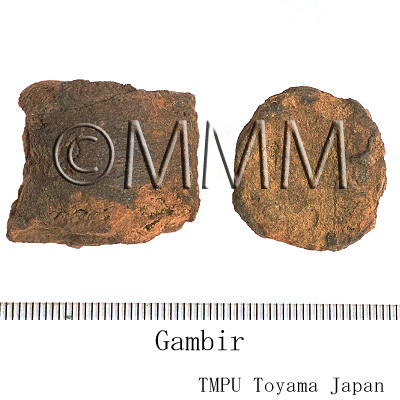Crude drug sample data base
※Click on the image to enlarge it.
Scientific information data base
| Crude drug name | Indonesian name, English name | Gambir, Pale catechu | ||||
|---|---|---|---|---|---|---|
| crude drug image |
| |||||
| Original plant name | Uncaria gambier Roxb. | |||||
| Family name | Rubiaceae | |||||
| Used part | Leaves | |||||
| Distribution area | It is cultivated in gambir plantation elsewhere in Indonesia (in Sumatera, Kalimantan and the surrounding islands), in lowlands [201]. | |||||
| Description | A woody liana, stem wooden and thin, reddish-brown in color, with broad-green leaves. Leaves opposite, 10 cm long, base is cat-like claw. Flowers originate at the base of the leaves where each pair of leaves may have a pair of globular inflorescences. | |||||
| Drug effect | Bitter, astringent [231]. | |||||
| Specific actions | Astringent, hemostatic [231]. | |||||
| Frequency in use | Moderate | |||||
| Common uses | Gambir is extract of leaves of Uncaria gambier It is sold in the form of small round cakes and is commonly used for chewing together with betel leaves. A little gambir and a pinch of lime is wrapped inside a betle leave and chewed, and upon chewing the secreted juice is swallowed or spitted. It is believed that chewing a betel leave with gambir and lime can promote healthy teeth and gums. In some places where gambir plantation occurred, the leaves are used instead of gambir for chewing. For this purpose, the leaves should be treated first, by boiling with water, pressing and drying to extract the catechine content. Batak people (in Sumatra) used the leaves as ingredients for cigarettes. To extract gambir, leaves were stripped from the twigs and boiled in water for an hour where all the juice was dissolved. The kettle has to be remained on the fire for another 4 hours in order to evaporate surplus water. Then the resulting sludge was put in reservoirs for drying and cut into small cubes. The cubes are then sun dried [201]. It is used for leather tanning and silk dyeing [201]. | |||||
| Side effect | The high tannin and catechin contents can irritate stomach and cause gastrointestinal pain. | |||||
| Pharmacological effect | Akaloidal extracts from U. gambier showed in vivo anti-hypertensive effects in various animal models. An extract of U. gambier containing catechin and tannin was found to control the growth of Fusarium sp. [220]. | |||||
| Medical system | Indonesian medicine (Jamu) | |||||
| Traditional usage | Gambir is a powerful astringent. It is used to treat chronic stomach disorders, dysentery, haemorrhage/hemorrhage, laryngitis, hoarseness. It is used in ointments to treat boils. Gambir is used to treat hoarseness and sore throat [201]. | |||||
| Formulation | 1) Diarrhea: 1 piece of gambir, 1 primary rhizome of turmeric, 1 handful of fresh aerial part of Euphorbia prostata are boiled with 110 ml of water. Drink 100 ml of the decoction for 3 days [231]. 2) Hoarseness and thrush: 1 piece of gambir, 3 pieces of leaves of Piper betle are boiled with 110 ml of water. Gargle twice a day with 100 ml of the decoction for 7 days [231]. | |||||
| References | Reference book Tips! | [201] K. Heyne, Tumbuhan Berguna Indonesia, Vols. 1-4, 1987. Diedarkan Oleh Koperasi Karyawan Departemen Kehutanan, Jakarta, Indonesia. Vol. 3, pp 1767-1775. [220] van Valkenburg, J.L.C.H. and Bunyapraphatsara, N. (editors). Plant Resources of South-East Asia No. 12 (2). Medicinal and posionous plants 2. Prosea Foundation, Bogor, Indonesia, 2002. pp 568-573. [231] Soedibyo, Mooryati: Alam Sumber Kesehatan: Manfaat dan Kegunaan (Natural resources for health. Benefits and uses). Balai Pustaka. 1998. p 138. | ||||
| Remarks | Uncaria gambier is well known as a dye and tannin-producing species, because of the atringent substance gambier [220]. | |||||
| Last renewal date | 2024/03/06 | |||||





